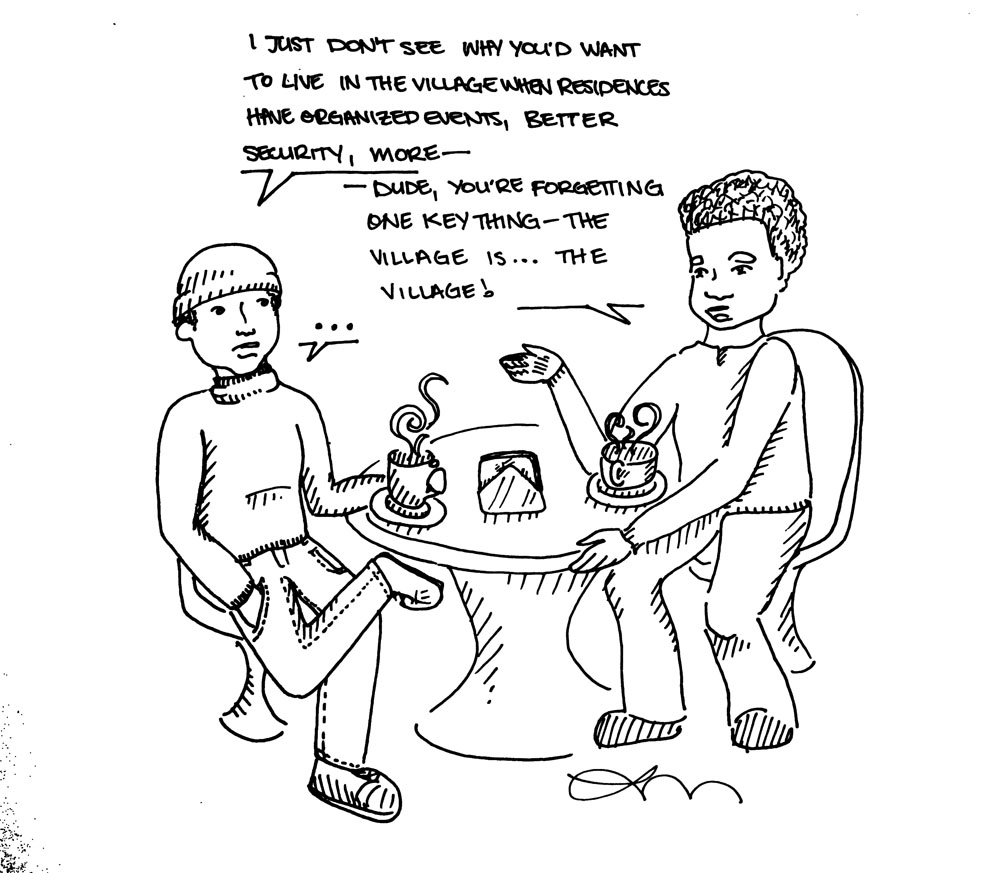Kate Hudson
Production Manager
As a former Founders college resident, it’s painful for me to admit the administration’s decision to close Founders College residence makes sense.
Residence life at York is dying. The numbers speak for themselves: York housing, in which Founders ranks dead last in terms of enrolment, is losing close to a million dollars of profit and 14 percent of its applicants a year. We could try to blame this on “commuter student apathy,” inadequate advertising or simply a shift in York’s approach to shaping its community; but the real culprit is the cheap, unregulated student housing right down the street.
Again, it’s all about the money. A quick Kijiji search finds me three or four options in the Village for $450 a month, utilities included. Rooming there instead of Founders would save me close to $1,500 a year.

Sure, I’ll miss out on the academic support services; the co-curricular opportunities; the sense of “neighbourhood” and community that the colleges have advocated for over the last 40 years at York. But I simply can’t afford it. Clearly, neither can York.
Instead I’ll be part of a growing, unregulated student ghetto notorious for crime, tenant mistreatment and inadequate living conditions.
Who let this happen?
More importantly, why is the university not using this very unfortunate blow to an important community – Founders College – as an opportunity to tackle the problems the Village has created head on? A “housing master plan for the longer term,” York’s answer to developing a strategy to saving – or perhaps dismantling – the residences is simply not enough.
We should know why the Village was allowed to exist in the first place. We should know what the university plans to do about it, besides using it as an opportunity to offset blame. And if nothing can be done to save the residences, which may very well be the case, we need to know how those re- sponsible for student well-being plan to protect future students from crime, abuse and sub-par living conditions.
A 2005 Task Force on the Colleges Report concluded that “one of the largest barriers we have at York is our lack of trust and cross-communica- tion.” It’s time to break down those barriers.
A village does not a community make



As a former resident of Tatham Hall (3 years in fact), and as someone who has lived in the village for 2 years, I would like to take the opportunity to correct some of the falsities that I have read in this article.
First of all, I would like to say that I strongly believe that any younger student, with the means to do so, should live in residence in their first year. It is a fantastic way to meet new people, develop a sense of community and it is a huge part of the university experience. For some students, residence life is so rewarding that they choose to stay, become residence council members or dons.
There are many things about residence life though, which may cause many students to reconsider returning for a second, third or fourth year. The first and most obvious reason is cost. This was touched on in the article, but let’s take a closer look at the numbers. If someone were to take a room in the most inexpensive buildings (Tatham, Winters, Founders, etc.), they would be paying a total of $5101. Over the 8 month period that we live in residence, this works out to about $637/month. But let’s not forget about the mandatory meal plan for these residences. The minimum amount you can possibly choose to pay being $3000. Of course that is $3000 that you can only use at fast food restaurants on campus, not on cheaper and healthier options like groceries.
Another reason many students desire to live outside of residence is the living conditions themselves. In first year, sharing a living room, kitchen and bathroom with 24 other students is a great way to meet people. But with this constructed community comes inevitable drawbacks. Common spaces are vandalized, food is stolen from the kitchen, and the washrooms are another story entirely.
In her article, Kate uses words like “crime” and “inadequate living conditions” to describe the village. In my third year in residence two people had their laptops stolen when they went to the bathroom leaving their doors unlocked. I witnessed multiple drunken brawls in the hallway outside my room, and more than one York University student living in residence has been attacked in their supposedly “safe” building. While living in the village I have never felt unsafe in my home. Mostly because, living in a house with only myself and close friends, I have more control over who can come in my house. Even in an apartment building, if your neighbour is having a party, at least their guests are not using your living room, kitchen or bathroom. And if you have rowdy neighbours or feel your safety is threatened, those responsible have to deal with the Toronto police, rather than the threat of a stern lecture from the don on duty.
As for the tenant abuse, yes, it happens. But anybody who is about to take on the responsibility of living on their own must also take the responsibility of knowing their rights asking their landlords for references. It is not like residence in that way, and that’s the point. It’s about being an adult and living with the decisions that you make.
In relation to the statistic that residence enrolment is down 14 percent, I honestly believe that is in reference to third and fourth year students not returning to residence which, before the village existed, many did due to a lack of available housing close to York.
To end on a personal note, I’m glad that the village is “allowed” to exist. I’m happy to call it home.